Today, natural natural landscape of the site is very popular among the gardeners. Such landscaping involves the use of at all exotic plants that are in bright and spectacular inflorescences, and more simple and familiar cultures. Often, such landscapes include water bodies and ponds, which also need a special framing. For this purpose, not all plants are suitable due to the proximity of water and high humidity, but gardeners and landscape designers have found a way out.
Gunner's plant is a real bright representative of the largest crops on the globe. After seeing Gunnera once, it is simply impossible to forget - large green leaves, like natural umbrellas, shelted near the growing plants. Gunner, landing and care for which enough simple and under the power of any gardener will become an excellent collapse of the artificial reservoir and will create a fabulous atmosphere on the site.
In this article, we consider the features and description of Gunners, we present the characteristics of the most popular varieties of this plant, as well as note the basic rules of agrotechnology of growing Gunners in the open ground.
Features and morphological description Gunners
Gunner is just a magnificent and amazing plant, which is not accidentally considered one of the highest and large in the world. It is a herbaceous rhizome perennial who belongs to the Slotnikovy family. In nature, these monumental plants prefer to settle on the shores of the reservoirs, on coastal rocks, where all conditions for active growth have been created for them. The homeland of these amazing plants is considered the territory of South America, namely Costa Rica, Chile, the areas of the Andes, as well as Australia. Today there are more than 30 varieties of Gunners, which have completely different features of the appearance. Among them are both plants giants and small bushes, whose leaves can grow as a couple of centimeters.
Gunner is a herbaceous plant for open soil, but many gardeners grow perfectly grow this perennial in containers and vases. For the first time, this bright plant became known in 1840, when it became actively cultivated. Gunner Gunner Guddral Community Bishop Drochheim Ernest Gunner, in honor of which this plant was named. This bishop part-time was also a botany, who was very interested in various unusual plants. In addition to the scientific name, this perennial has also received folk, which sounds more than spectacular - dinosaur food. This characteristic is primarily connected, first of all, with the colossal dimensions of the leaves of Gunners, which can grow to a height of up to 3-4 meters and, therefore, could serve as feed for dinosaurs. In English-speaking countries, you can often find another name Brazilian Giant-Rhubarb - brazilian giant rhubarb.
Gunner description:
- Gunner is considered a rhizable grassy perennial, which is perfectly held by its root system for the rocky shores of reservoirs and lakes.
- Interestingly, Gunner is an evergreens plant that can decorate the plot throughout the year with its green huge foliage. However, in a temperate climate, it relieves foliage, it is not necessary to worry - the spring decorative look will be restored.
- Gunner is not in vain called a giant, because in height, all the plant can reach about 3-4 m. This concerns not all varieties of culture, as among 30 representatives of the genus there are specimens that can grow only 1-1.5 with leaves 10 cm long.
- This decorative deciduous plant has a strongly branched and powerful root, due to which it can be fixed along the reservoirs.
- Stems from Gunners Relief, reprehension, height can reach 2-3 meters. In the form rounded, very thick and covered with peculiar spines.
- The main decoration of the plant is the leaves. Sheet plate of round shape, very large sizes, dwelling and rough. The leaves on long stiffs are attached, which also have small spines on their surface. In its appearance, the leaves resemble huge umbrellas. If you first see the Gunneru with her leaves on the site, you can take it for Borschevik, but unlike the latter it is not poisonous.
- The leaves of grassy culture have a bright green color and amazed with their sizes. One sheet plate in diameter can reach 1.5-2 meters. Such dimensions can be achieved in the cultivation of Gunners in the warm regions, for example, in Crimea or at the homeland of culture in Brazil. In a moderate climate, the leaves will be much more modest.
- Due to the large leaves, the plant in width can grow to 3-4 meters, so when landing on its site it is important to calculate the appropriate place in advance.
- Blossom is not so decorative as the appearance of the leaves. Flowers are small, assembled in a co-shaped inflorescence, which resembles corn pillage. The shade of colors is pinky, sometimes it can become reddish and even green.
- The very beginning of flowering of this culture falls on May-June.
- Gunner is characterized by a rapid growth rate, due to which in a short time it fills all the space. One plant can grow into an area of \u200b\u200bup to 5 square meters.
- The plant is quite thermalized, therefore, it can grow only in the territories with a mild climate. In moderate regions, it is recommended when growing a gunner in an open ground for the winter digging the rhizome.
Use Hunners in the landscape
Gunner is an excellent solution for landscape design, which in recent years is actively used to landscap the site, especially in regions with a mild climate - for example, Krasnodar region or Crimea. Consider the main applications of Hunners in the landscape:
- Gunner plant for water bodies is the best option. It looks great in combination with other water cultures.
- You can land this majestic giant and in stony gardens.
- Gunner looks good on the background of a lawn in single landings. This plant is absolutely no need for the neighborhood of other decorative crops - it looks like it is impressive. It can be landed near the house for the shade or near the fruit and garden trees to create a shadow composition.
- Some gardeners are grown by Gunnera in cool greenhouses or in personnel indoors. In this case, the size of the culture is not so great.
- When creating large garden compositions, you can apply a gunner to framing paths or sidewalks. Thus, they will create a kind of green corridor and at the same time give a shadow.
Variety of species and varieties of Hunners
Today in the Nature of South America and Australia there is a sufficiently large number of high species, which are distinguished by the appearance, dimensions of the sheet plate and other characteristics. Consider popular varieties of this unique plant.
- Gunner dye. The scientific name of this plant G. Chilensis or G. Scabra. One of the most popular species of plants, the natural habitat of which is considered the territory of South America. It is an herbby decorative-deciduous perennial, which can be 1.5-2 meters in height. It is characterized by large leaves, the diameter of the sheet plate can be 1-1.5 meters. The leaves grow on long stiffs from the pubescent root. In the form of a slightly angular rounded, rough, with a toothed edge. Flowers at a variety of small, greenish-red shades, collected in cooled inflorescences. After their efforts, reddish fruits appear on the stems.
- Hunner bush. This species is considered the most popular and common, so in garden shops to buy a hunter's huteness much easier than other varieties. Scientific name G. Manicata Plants. It is a high herbaceous plant that has decorativeness in the form of just huge leaves. In height, it can reach about 3 cm, and it grows greatly into a width - up to 4 meters. The leaves are large, the diameter of the sheet plate can be approximately 1.8-3 meters. In the climate of Russia, you can get a Gunneru of this type with more modest parameters. The leaves are rounded, housing, with a toothed edge, a little rough. Stems and sweets are covered with small spines. Flowers with small reddish flowers, which are assembled into tight inflorescences, similar to corn by the car.
- Gunner Magelskaya. It is a dwarf grassy plant that can form mats up to 10 cm in height. The leaves at variety are small, just 5 cm long. The form is slightly rounded, with a beautiful corrugated and a little toothed edge. During flowering, small greenish-yellow flowers collected in inflorescences are blooming. After the flows of colors, beautiful fruits of a reddish or orange shade appear. It is because of the bright fruits that this species is popular as a pot culture.
- Gunner creeping. Also a low-speed representative of this plant, the height of which can be maximally only 10 cm, while spreading into width by 40-45 cm. Purple-green leaves are small, up to 3 cm long, have a gear edge. After biting inflorescences, beautiful reddish or purple fruits appear.
Gunners reproduction: the most common ways
It is not so difficult to grow a gunner on its plot, problems may arise with the wintering of this thermal-loving plant. However, with a great desire, it can be planted in containers. In order to propagate the gunner on their own, there are several ways. First of all, it is seed reproduction and by dividing the root or bush. Consider the main features of the rules of each cultivation option.
Seed reproduction of Hunner
- The seed reproduction of this plant is advisable to use if there is still no such unique grassy perennial on your site.
- First of all, you need to stockp material. To do this, it can be obtained by gathering ripe fruit in autumn with an already existing adult plant. In another case, you can just buy seeds in any garden store. Gunners seeds are small, round shape, bright yellow-orange shade.
- It is preliminarily to accelerate the timing of seed germination, they are desirable to soak them in a solution of the rooting agent for about 30 minutes. After that, the planting material is drying.
- Seed seeds at seedlings at about late February or early March. To do this, it is necessary to prepare a single pot for each seed or one common container.
- For seeding, Gunners seeds are recommended to use an soil mixture consisting of peat and humus. Soil must be covered with a container and rolish with water.
- Next, take the plant seeds and distribute them along the surface of the soil. It is best to sow portray that in the future it was easier to dive seedlings, without fearing to damage the gentle root system.
- Falling the planting material is not needed, slightly pressing into the ground. After sowing, it is necessary to all pour everything, while it is necessary to do this in such a way that there was a small puddle on the surface of the soil. Gunner loves moisture and her seeds so better germinate.
- The container from above is covered with glass or film, after which it is put on a bright place in a comfortable temperature in the room. If cloudy weather is on the street with rains, it is recommended to organize highlighting with lamps.
- When the seedlings appear 2-3 strong and healthy leafs, they can be seen in separate pots with nutritious and fertile soil.
- In the future, the care of seedlings is regular watering while drying the soil and carrying out crops.
- In the open soil, young plants are planted at around the end of May or in early June, when the threat of return freezers passes.
Gunner reproduction by rhizome
- Gunnera propagate can be both in a different way. Periodically, this plant needs to rejuvenate and disperse, for which the method of dividing the bush or rhizoma is applied. If an adult plant is growing on your site, it can be used to get young decene.
- Gunneur the rhizomic division is recommended in the spring when the last frosts will be afraid.
- For this shovel, carefully you need to beat an adult bush in a circle so as not to damage the roots and alleviate the plant extraction itself.
- Next, gently remove the rhizome gunners and put it on the surface of the soil.
- With the help of a sharp knife or a secaterator, the rhizome of the plant should be divided into several deteen in such a way that each part has enough roots and shoots.
- Sections of sections can be sprinkled with crowded charcoal to avoid infection and posting.
- After dividing, young plants must necessarily fall at the prepared landing wells.
Landing Gunners in Open Soil
Gunning a gunner on its plot is a fairly simple process with which even a novice gardener can cope. To obtain a beautiful and spectacular plant, it is important to comply with all stages of preparation and rules for the planting process.
Stage 1. Selection and purchase of landing material Hunners
- First of all, each gardener needs to think about the purchase of high-quality planting material. Gunner is a fairly rare plant for the territory of Russia, so the purchase of seedlings or other planting material may be a rather complicated process.
- The planting material can be found in the form of seeds in bags and in the form of seedlings in separate pots.
- It is important to buy a Gunnera only in specialized garden centers or nurseries that are engaged in breeding plants. So you will be sure that you buy Gunneru, and not another plant, for example, Borschevik, which is very similar.
- When buying seeds, pay attention to the shelf life. And when purchasing seedlings of culture, first of all, it is worth considering the stem and leaves carefully, as well as the soil that should be clean and moistened.
- When choosing a Gunner variety, focus on the future place landing. A tall variety can be planted with a soliter or along the reservoir, dwarf species are perfect for borders or rocky gardens.
Stage 2. Selecting a place for landing Gunners
- The next preparatory step is the choice of landing place of Gunners.
- First of all, it is important to choose a relatively spacious plot, since Gunner grows very quickly and takes up to 4 meters in diameter.
- This plant can grow perfectly on the illuminated area or in place with a light half.
- It is best to plant a hunter in close to natural places. This applies to the shores of artificial ponds and water bodies, you can land and near the fountains.
- The landing place should be protected, only a small draft without strong wind gusts is allowed.
- A specific choice of place for landing will be directly dependent on the desired landscape design. It can be a solitary landing, a garden composition with trees, landing along the sidewalks or in public.
Stage 3. Choice and soil preparation for Hunner
- Gunner for obtaining large sizes and large leaves should grow on fertile and nutritional soils, it is desirable to choose a slightly swampy plots.
- Perfect for landing loose sublinous soil with high humidity and soft acidity.
- Before boarding, it is important to carefully switch the selected area, in the process, be sure to make some fertilizer. You can use the organic or complex mineral fertilizers.
Stage 4. Planting the Gunner in Open Soil
- In the open soil, Gunners seedlings are planted only after establishing warm weather when the threat of frosts is passed. This is usually happening at about late May or in early June.
- Previously, it is necessary to prepare landing pits for seedlings. Their size must correspond to the size of the root system of Gunners together with an earth's room. If you decide to plant several copies of the seedlings of this unique plant, then do not forget to leave a sufficient space between the landing wells. On average, there should be 2-3 meters between the plants.
- The soil mixture is desirable to use the nutrient and loose, the sandy soil is suitable with the addition of humus as a fertilizer.
- Before falling down, do not forget to shed water pots with seedlings to facilitate the extraction of the planting material.
- Carefully place a seedling with an earthen room into a prepared well and suck it with soil.
- After landing, plenty of young plants with water.
Agrotechnics of growing Gunners: Secrets and nuances of care
Care for this culture is peculiar, but it is not distinguished by complex processes and the need to master new methods. It is enough to regularly pay attention to the plant and it will delight you with decorative appearance.
- Watering. Gunner is a moisture-loving plant that requires for active growth of swampy soils. In connection with this, watering should be regular and abundant. If the plant is planted in open solar plots, then watering should be even more frequent and abundant. Do not be afraid to pour the culture, moisture Hunner loves very much.
- Loosening and mulching. Periodically, the soil around the plant must be loosened and removed weeds. In order to prevent excessive evaporation of moisture, the soil around the plant is recommended to climb by humus.
- Feeding If the soil at the landing site is sufficiently nutritious and fertile, then in the future Gunner will need only in a few feeders per season. In this case, you can use organic fertilizers like a cow's solution or complex mineral fertilizers.
- Fighting diseases and pests. This plant has good immunity to various pests and diseases. So that your bush has always been beautiful, it is only important to follow all rules of care.
- Shelter for the winter. Gunner can withstand a decrease in temperature up to minus 15 degrees, so in the southern regions of Russia this plant can winter in the open ground. It is enough to glue peat and cover the foliage on top. In more central regions with temperate climates and cold winters, the rhizome of the plant must be pulled out and placed in a container with soil, which put in a cool room. In the spring rhizome planted at a permanent place.
Gunner - Photo
Today, at the disposal of gardeners there is a colossal number of plants that are distinguished by bright features of the appearance. The Monumental Gunner Plant is a spectacular and unique grassy perennial, which is capable of eclipsed with its majestic sizes, even the most beautifully blooming decorative shrub. At the same time, landing and gunner care is quite simple, agrotechnology allows you to grow a plant even in Russia.


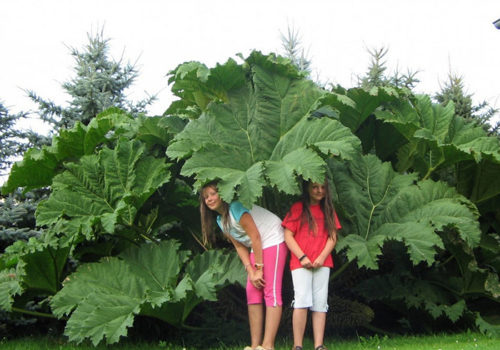
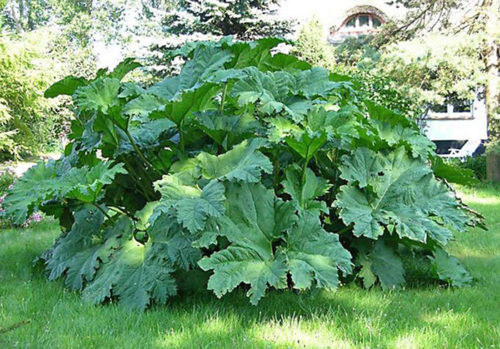
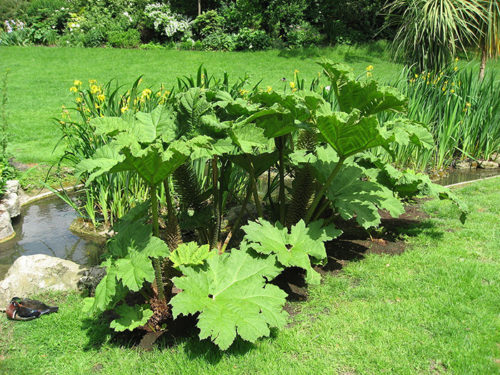
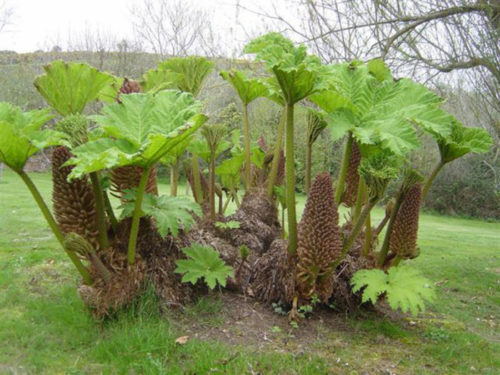
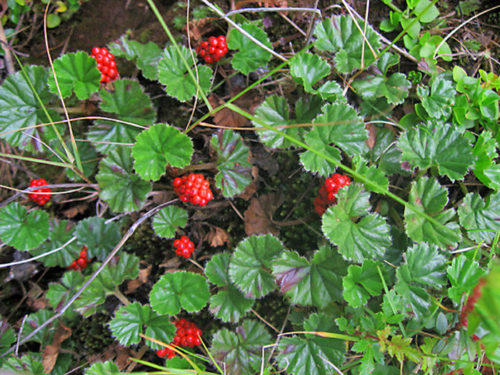
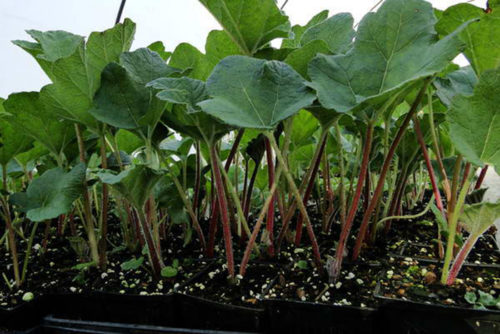
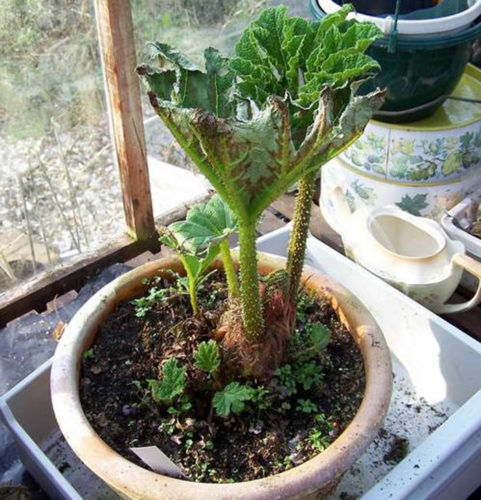
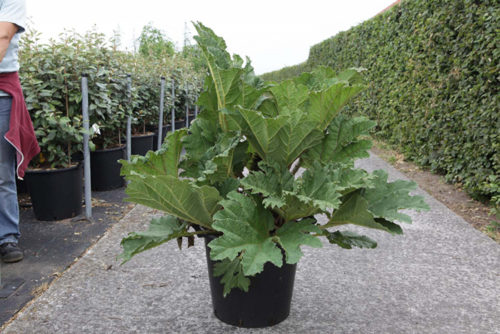
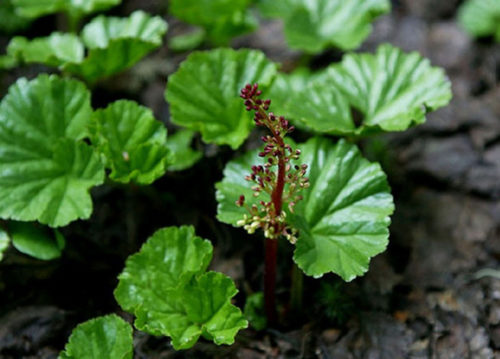
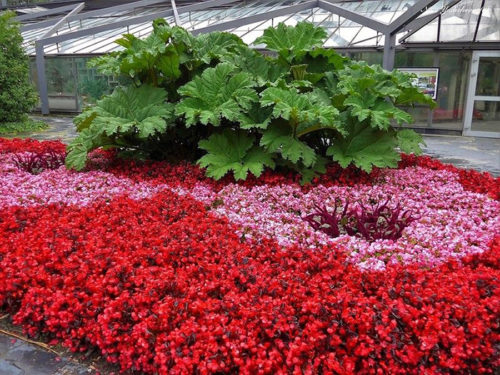
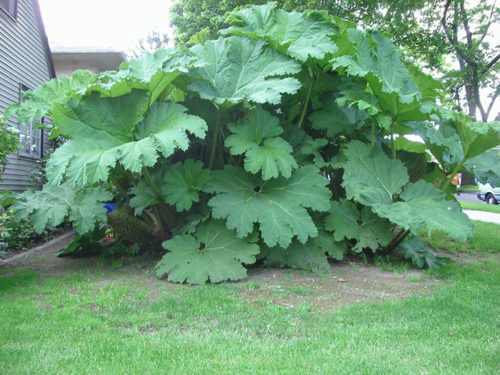
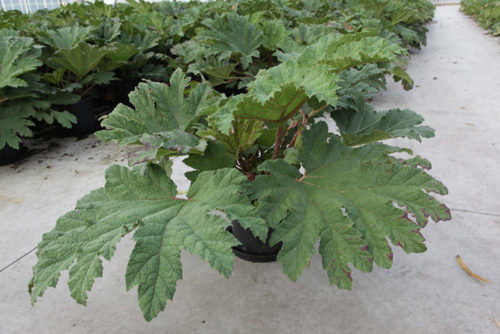
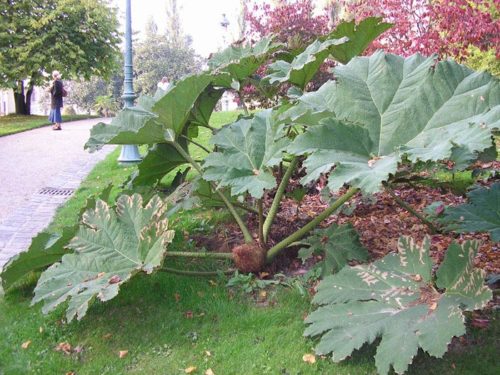
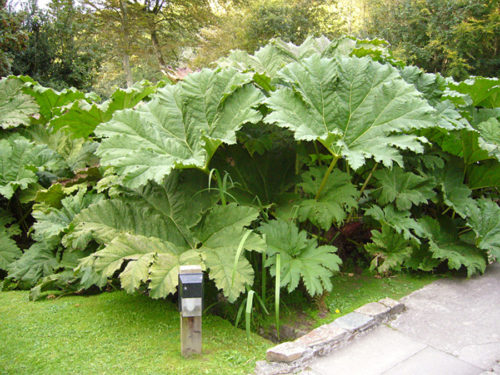
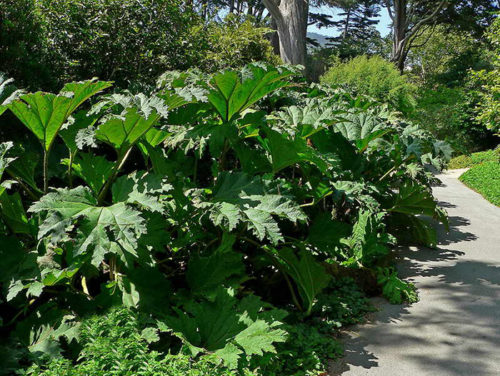












 Start a discussion ...
Start a discussion ...